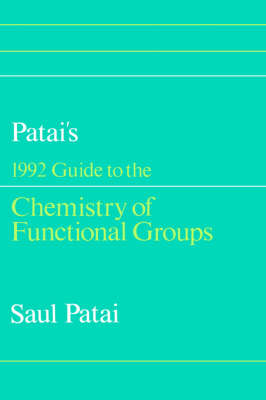Patai's Chemistry of Functional Groups
4 total works
Patai's 1992 Guide to the Chemistry of Functional Groups Saul Patai, The Hebrew University of Jerusalem, Israel Ever since the publication of the first volume of 'The Chemistry of Functional Groups' in 1964, the Patai series has acted as an essential reference source to many researchers. By the end of 1991, the series consisted of 50 titles bound in 73 volumes, containing nearly 900 chapters written by over 1250 authors. The aim of this Guide, as was that of the previous edition, is to present sufficient material on each of the published chapters to allow the researcher to decide whether these chapters are relevant and useful for his or her purpose, and thus worth pursuing in full. For those who are familiar with only selected volumes from the series, the cross-referencing between complementary and related chapters from different volumes will be invaluable. The Guide is fully indexed by both subject and author thus making it an essential reference tool for all organic chemists.
In this handy reference guide and index to the volumes in the
The Chemistry of Functional Groups series, all volumes are indexed and cross–referenced (according to related and complementary chapters). Users of the series will find this volume indispensable for finding information quickly and easily.
The Chemistry of Functional Groups series, all volumes are indexed and cross–referenced (according to related and complementary chapters). Users of the series will find this volume indispensable for finding information quickly and easily.
The Chemistry of Sulphonic Acids, Esters and Their Derivatives
by Saul Patai and Zvi Rappoport
Published 16 January 1991
The series "The Chemistry of Functional Groups" is designed to cover in each volume all aspects of the chemistry of one of the important functional groups in organic chemistry. The emphasis is on the preparation, properties and reactions of the functional group treated and on the effects which it exerts both in the immediate vicinity of the group in question and in the whole molecule. The general plan of each volume is the same. An introductory chapter deals with the general and theoretical aspects of the group. Chapters discuss the characterization and characteristics of the functional groups, ie qualitative and quantitative methods of determination including chemical and physical methods, MS, UV, IR, NMR, ESR and PES - as well as activating and directive effects exerted by the group and its basicity, acidity or complex-forming ability. One or more chapters deal with the formation of the functional group in question, either from other groups already present in the molecule or by introducing the new group directly or indirectly. This is usually followed by a description of the synthetic uses of the group, including its reactions, transformations and rearrangements.
Additional chapters deal with special topics such as electrochemistry, photochemistry, radiation chemistry, thermochemistry, syntheses and uses of isotopically labelled compounds, as well as with biochemistry, pharmacology and toxicology.
Additional chapters deal with special topics such as electrochemistry, photochemistry, radiation chemistry, thermochemistry, syntheses and uses of isotopically labelled compounds, as well as with biochemistry, pharmacology and toxicology.
Considerable advances have been made regarding the chemistry of triple-bonded functional groups since the first volume in this series was published. This updated version covers information which has been reported during the last 15 years.


